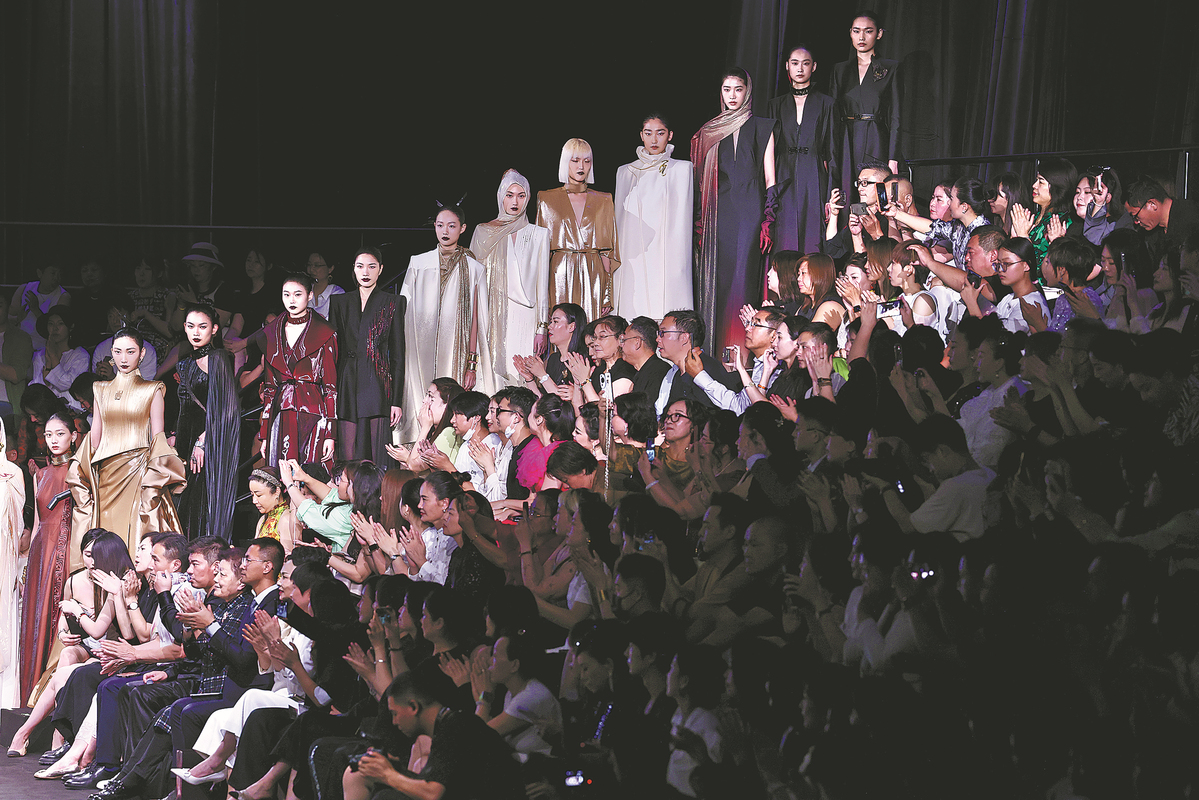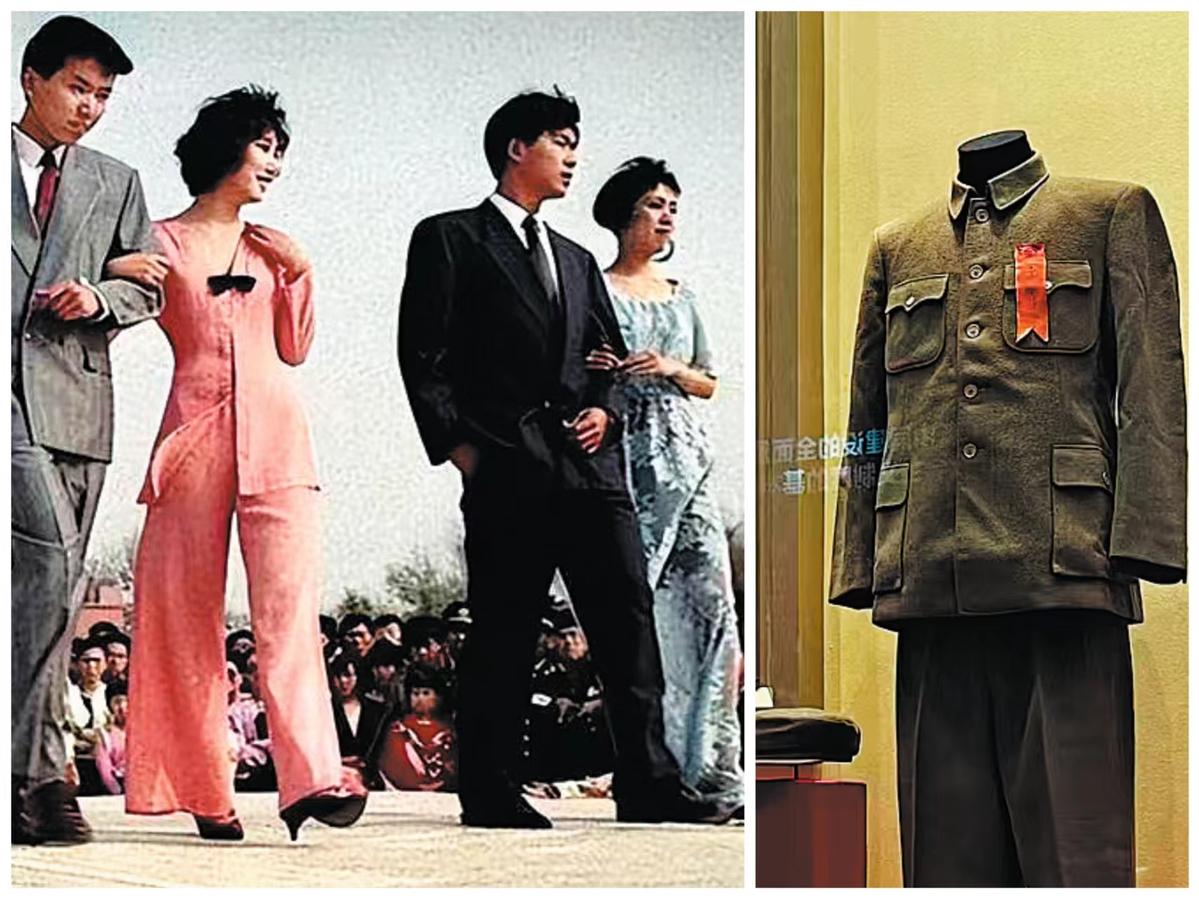

A scene from China International Fashion Week in September last year. [Photo/China Daily]
At 3 pm on Oct 1, 1949, Chairman of the Communist
"For 75 years, this moment has been viewed by generations of Chinese as a deeply emotional milestone in contemporary Chinese history. Yet not many are aware of the fact that almost all who had turned up at the tower that day, including Chairman Mao himself, was wearing a special type of formal suit known in China as the Zhongshan suit," says Liu Wei, a professor from the Beijing Institute of Fashion Technology, one of China's top fashion colleges.
For those unfamiliar with the history, Zhongshan is the name of Sun Zhongshan, more commonly known as Sun Yat-sen (1866-1925), a Chinese revolutionary widely revered for his instrumental role in the 1911 Revolution, which overthrew the rule of China's last feudal dynasty — Qing (1644-1911).
With its stand-up collar and buttoned-up design, the Zhongshan suit (Chinese tunic suit), combining traditional Chinese aesthetics with a Western cut, endeared itself to Sun and his progressively minded countrymen who wore the design proudly, partly as a call for change.
"The suit got its name not from Sun himself but from his followers and admirers, including Mao, who decided to continue what he started," says Liu, who has researched and written extensively about the history of Chinese fashion.
According to Liu, Chinese fashion in the 1950s and 60s was characterized by uniformity and practicality, due to the dominant social ideology and the era's economic situation. Somber, muted colors like "army green" and "police officer blue" reigned. Functionality was prioritized; and a straight cut was favored for its minimal use of material.
"The need to feed and clothe everyone was pressing. And it was against this background that the Huadong Institute of Textile Science and Technology, the very first of its kind, was founded in Shanghai in 1951," says Liu. "Huadong" means East China, where Shanghai is located.
This was followed eight years later by the founding of the Beijing Institute of Textile Science and Technology, which changed its name in 1961 to the Beijing Institute of Synthetic Fiber Engineering, and again in 1988 to the Beijing Institute of Fashion Technology, or BIFT.
"The name changes were reflective of the larger trends both within the industry and across society," says Liu, pointing to a type of polyester fabric whose durability and wrinkle resistance had made it so popular among Chinese between the 1960s and 70s that it was effectively dubbed "di que liang", meaning "really good".
In the case of the second name change, the decision was made a decade after the official start of China's reform and opening-up in 1978. Spearheaded by Deng Xiaoping, whom many today regards as the initiative's "chief architect", the reform focused on transitioning Chinese economy into a more market-oriented one and making the country more connected to the rest of the world.
The message was sent out, first and foremost, by top Chinese leaders donning Western suits, which had been absent from view for the previous decade as China weathered the tumultuous "cultural revolution" (1966-76).

Left: The first generation of Chinese models walked onto the stage after the country's reform and opening-up was officially launched in 1978. Right: The Zhongshan suit worn by Chairman Mao Zedong on Oct 1, 1949. [Photo provided to China Daily]
One Chinese city to feel the immediate effects of Deng's reform measures was Guangzhou, capital of Guangdong province, whose historic name "Canton" was familiar to those working in trade between China and the West during the 18th and 19th centuries. Adjacent to Hong Kong, the port city became a bridge between the Chinese mainland and the global fashion and textile markets, and in that process transformed itself into China's first fashion hub.
"With preferential treatment for investors, many of whom were from Hong Kong and Taiwan, the factories in Guangdong started to manufacture at an unprecedented scale, mostly with materials and samples provided by whoever placed the order," says Liu. "Many who had placed orders were European fashion companies who decided not to deal with the Guangdong factories directly but instead through their business partners in Hong Kong. But it didn't take long before they switched, as Guangdong rose in prominence as 'the world's factory'."
It's no coincidence that the very first joint venture between the mainland and Hong Kong was a factory located in Guangdong's Dongguan city that produced sample-based handbags. From Guangdong, the influence of Western fashion started to spread throughout the rest of China, first in trickles then in waves.
By the time Yang Jie, Liu's colleague at BIFT, was in middle school in the mid-1990s, the cultural impacts of opening up were fully felt. "Film, music, fashion, hairstyles… they were all one package," says the 42-year-old. For him and many of his peers back then, Hong Kong entertainment stars, whose images flooded TV screens, were indisputable fashion icons.
"Those were the days when young people dressed up like hippies and danced to loud rock music pouring out of cassette players," continues Yang, who remembers vividly wearing a leather jacket to school before anyone else and was gently reprimanded by the head teacher to put his studies first. "The economic reform had led to a substantial improvement in living standards for the average Chinese, which led to an explosion of ideas and a newfound need for self-expression, which the younger generation reveled in. Fashion allowed them to make bold statements, not completely unlike the way the revolutionaries did with the Zhongshan suit."
"And you know what's so great about that moment? The internet had yet to appear, which meant we didn't have many references while trying to interpret fashion. As a result, people came up with their own answers, which sometimes resulted in raw creativity," Yang says.
The leather jacket, which Yang wore with great panache — so he thought — was given to him by his mother who belongs to China's Miao ethnic group, whose members were known as gifted singers and dancers and whose traditional clothing often features intricate, colorful embroidery.
"Unlike most of my older family members who would often dress up from head to toe in ethnic attire, my mother loves to deck out her traditional looks with a few modern pieces. She instilled in me an idiosyncratic sense of fashion long before I studied it, first at BIFT and then at a fashion institute in Milan," says Yang.
In 2006, Yang opened BIFT's first menswear courses after returning from Italy. "What I have come up with as a designer today represents everything I've been through — physically, emotionally and aesthetically," he says. "I believe it's the same for Chinese fashion."
